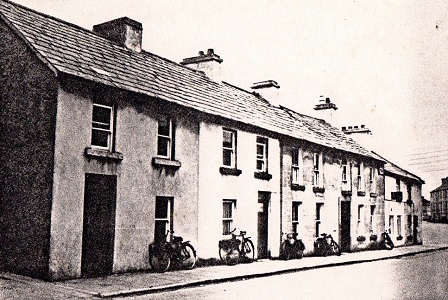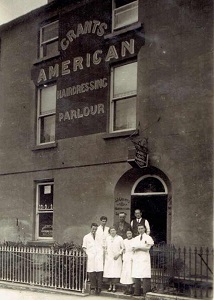Old Galway
O’FLAHERTY’S GARAGE

by Tom Kenny
Patrick O’Flaherty bought an old thatch cottage in 1901 and converted it into a two-storey house which would become numbers 15 and 16, Upper Dominick Street, part of which became a small shop operated by his wife Aggie (née Staunton) and part became O’Flaherty’s Garage. They operated a hackney service and advertised “Galway’s leading hire service in luxurious charabancs and motors (touring and saloon). All tours through beautiful Conemara radiate regularly from O’Flaherty’s”.
It was Patrick who did the funeral arrangements for Fr. Griffin in spite of warnings from the Black and Tans. They later caught him and killed him. In 1927, a local newspaper stated that “The enterprising motor garage proprietor Michael O’Flaherty (son of Patrick) was the proud possessor of a fleet of modern omnibuses and charabancs. His principle, which might well be emulated by those desiring to encourage local manufacturers and traders, was to purchase engines and chassis and get the bodies built to his own design at home. He was the first in Galway to give an order for a motor body to the local firm of Messrs. Fahy Brothers, Coach Builders, Forster Street, and since then, they have built 17 bodies for him, including motor hearses”.
BIANCONI IN GALWAY

by Tom Kenny
Charles Bianconi is generally regarded as the man who put Ireland on wheels. He developed a network of horse-drawn carriages that became Ireland’s first integrated transport system, building on the existing mail roads and coach roads that were already there. There was a general tax on coaches at the time which precluded the middle classes from using theirs, and a relatively peaceful period after the battle of Waterloo meant that a great many horses, bred for the army, became cheap on the market. His system offered connections with various termini, his prices were cheap and so he was well patronised, in spite of the discomfort felt by passengers. Often, when going up a hill, some passengers would alight to make the carriage lighter for the horses.
Weather was an important factor in the journey. A Prussian historian was the only person on board on one of those trips who had an umbrella. “The two young girls crouched down at our feet while the other four moved their faces so close to the shaft of the umbrella that their noses were almost touching. The old woman rested her head on my right shoulder while the gentleman on my right rested his head on my left shoulder. Through this ordeal by water, we had, within a short time become friends and acquaintances and I received much praise for my considerations and humanity”.
PEADAR O’DOWD, THE PASSING OF AN OLD GALWEGIAN

by Tom Kenny
Peadar O’Dowd’s credentials for writing about Galway were impeccable. One of four children, Nono, Willie, Martin and Peadar born to their parents John and Bridget, he grew up in Bohermore and was always grateful for the fact. He lived his life there and throughout that life would celebrate the area and its people in hundreds of articles and interviews he published in various newspapers and journals.
He was educated in St. Brendan’s in Woodquay and in St. Mary’s College where he spent ‘five of the happiest years of his life’ and later completed a Commerce degree in UCG. Having graduated, he taught for a year in “The Mon”, then went to teach in St. Benin’s Vocational School, Glenamaddy where he also managed to coach the camogie team to win the County Schools championship in 1969. He eventually moved on from there to join the staff of The Regional Technical College as a lecturer in Business Studies. He was fortunate to meet and marry Mary Langan from Cross, Co. Mayo.
THE MERRYWEATHER

by Tom Kenny
Moses Merryweather and his son Richard lived in Clapham, London and they worked with the engineer Edward Field on putting his design of a vertical boiler onto a horse-drawn platform. They successfully applied it for use in their steam fire engine thus improving water pressure and making it easier to use, once steam had been got up. It was reckoned that the engine could get up enough pressure to pump within ten minutes of a call out. The fire could be started before leaving the station so there could be enough pressure by the time they arrived at the scene of the fire. In 1899, Merryweather produced the first successful self-propelled steam fire engine. Appliances were available in small sizes suitable for a country house pumping around 100 gallons per minute. A common size, popular with Borough Fire Brigades was the double vertical boiler that could pump between 250 and 400 gallons per minute.
THE LITTLE SHOPS OF BOHERMORE

by Tom Kenny
There were a few little shops at the top of Prospect Hill leading up to Bohermore -- Kelly’s shop was where you got the thickest penny ice cream between two wafers. There was McInerey’s, Mary kate Mahon’s and Lohan’s chemist. Almost next door was Tom Duffy, the tailor. On the other corner of Biddy’s Lane was Molloy’s little shop – neat as a pin.
Across the road from Water Lane was a small shop which later became Sharkey’s. I vaguely remember a fish and chip shop and even a small laundrette along that row. Mr. Cloonan, the carpenter, had a coffin shop along there also. He was a very friendly man. If his door was open when we were passing, being children, we were afraid to look in in case there might be a fully occupied coffin looking out at us.
Crowe’s Bar, Paddy Hogan’s Pub were close to each other and Luke Doherty’s Pub was directly across the street. The three proprietors would stand at their doors after last mass on Sundays, hoping to attract customers to their house. They were known locally as ‘the Father, the Son and the Holy Ghost’ – I never knew which of them was which.
THE HOMES OF WOODQUAY

by Tom Kenny
As we pointed out last week, much of what we now know as Woodquay was under water until the funnelling of the various streams that came down from the Corrib into the river that we know today began in the mid-nineteenth century. As part of the project, the lands of Woodquay were gradually reclaimed. The people living in the area in those early years were mostly small farmers and fishermen. Their houses were very basic, single story, and for the most part, thatched and built of crude stone. There were of course some landmark houses but things began to change generally around the turn of that century with the construction of terraces of new slated houses around the broad space of Woodquay as we know it today, mostly built by the Urban District Council.
MARKET DAY IN WOODQUAY

by Tom Kenny
MARKET DAY IN WOODQUAY
There were a number of aspects to the market in Woodquay in the nineteenth and early twentieth century – there was a crane for weighing potatoes at the end of the park (near the toll booth) and it was there many of the farmers who carried their wares downriver used to gather to sell. Other groups would congregate here to sell scallops for thatching houses, ‘flexible sticks’ cut from hazel trees. These were very much in demand in the city area as so many houses were thatched in those days including in Woodquay. Also in that area you would find basket makers who would weave creels, ciseáins, skibs and baskets of many shapes and sizes for sale to the public.
AN AMERICAN BARBER SHOP IN EYRE SQUARE

by Tom Kenny
John Joseph Grant emigrated to Brooklyn in New York where he learnt the haircutting trade and obviously made enough money which enabled him to come home in 1912 and set up his own business here. He also picked up quite a few tips on advertising as well as you can see from our illustration which was published c.1913. In addition to being a skilled barber, he certainly was not shy about promoting his wares – his advert is full of superlatives. “I guarantee to cure dandruff – the most modern and up-to-date barber’s shop in the Provinces –shaving soap solely manufactured by J.J. Grant – you will never get bald if you use Grant’s Imperial Hair Tonic (He must have sold this product out as he himself went bald in later life).
